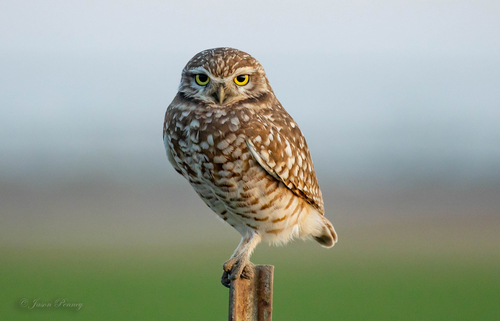
Burrowing Owl
The Burrowing Owl (*Athene cunicularia*) is a small, long-legged owl found throughout open landscapes of North and South America. Unlike most owls, Burrowing Owls are active during the day, especially at dawn and dusk. They are unique for their preference for nesting and roosting in burrows, often those dug by prairie dogs, ground squirrels, or other animals. Their ecological role includes controlling populations of insects and small rodents, contributing to the balance of their grassland and desert ecosystems. Culturally, they are sometimes seen as symbols of wisdom or guardians of the underworld in various indigenous traditions.
19-28 cm
Length
50-61 cm
Wingspan
Least Concern
Conservation Status
Distribution
Burrowing Owls are found from western Canada and the United States, through Mexico and Central America, and into South America as far south as Tierra del Fuego. Some populations are migratory, with northern birds moving south to the southern U.S. and Mexico for winter.
Lifespan
6-8 years in the wild, up to 10 years in captivity.
Burrowing Owl's Habitat
Habitat Types
Grasslands, Prairies, Deserts, Savannas, Agricultural fields, Urban and suburban open areas
Climate Zones
Temperate, Subtropical, Tropical, Arid, Semi-arid
Adaptations
Burrowing Owls have adapted to open habitats with low ground cover. Their long legs aid in seeing over tall grasses, and their burrowing behavior provides protection from predators and extreme temperatures. They are well camouflaged with earth-toned plumage.
Variations
There are many recognized subspecies (around 18-22), varying in size, coloration, and migratory behavior. For example, Florida Burrowing Owls are generally non-migratory and have slightly different plumage characteristics compared to western subspecies.
Appearance
Breeding Plumage
Plumage is generally similar year-round, though it may appear slightly brighter or more contrasting during the breeding season due to feather wear.
Seasonal Feather Changes
Minimal seasonal variation, primarily related to feather wear and fading.
Sex Based Plumage Differences
Males and females have very similar plumage, although males may be slightly lighter in color on average.
Notable Features
Bright yellow eyes, Long legs relative to body size, Lack of ear tufts, Prominent white eyebrows, Brown plumage with white or buff spotting
Diet and Feeding
Primary Foods
Insects (especially beetles and grasshoppers), Small mammals (mice, voles, ground squirrels), Small birds, Reptiles and amphibians, Scorpions
Foraging Behavior
Burrowing Owls hunt by walking, hopping, or running along the ground, as well as by swooping down from a perch. They also hover in the air before diving on prey. They are opportunistic feeders, taking advantage of whatever prey is most available.
Specializations
Their long legs allow them to run and pursue prey on the ground effectively. They can also catch insects in mid-air.
Seasonal Diet Variations
Diet varies depending on prey availability. In summer, insects often make up a larger portion of the diet, while in winter, small mammals may become more important.
Behavior
Social Structure
Burrowing Owls are often found in loose colonies, especially during the breeding season. Outside of breeding, they may be solitary or form small groups.
Communication
Variety of calls, including cooing, chattering, and hissing sounds, Head bobbing, Bowing, Bill snapping
Migration
Some populations are migratory, while others are resident year-round. Migratory populations typically move south for the winter, following food availability.
Territorial or Group Behaviors
Burrowing Owls are territorial, defending their nesting burrows from intruders. They may also engage in cooperative hunting and mobbing of predators.
Conservation
Threats
Habitat loss and degradation (due to agriculture, urbanization, and development), Decline in burrowing mammal populations (prairie dogs, ground squirrels), Pesticide use (reducing prey availability and causing direct poisoning), Vehicle collisions, Predation by larger raptors, coyotes, and domestic animals
Protection Programs
Habitat restoration and protection, Installation of artificial burrows, Relocation programs, Monitoring of populations, Public education and outreach
Local National Laws
Protected under the Migratory Bird Treaty Act in the United States, Canada, and Mexico. Various state and provincial laws also offer protection.
Population Trend
Declining in many areas, especially in the northern and western parts of their range.
Population Estimates
Global population estimated to be around 2 million individuals, but with significant regional variations.
Interesting Facts
Burrowing Owls often line their burrows with animal dung.
This is thought to attract insects, providing a food source for the owls and their young.
They can mimic the rattling sound of a rattlesnake.
This is believed to be a defense mechanism to deter predators from entering their burrows.
Young Burrowing Owls can run surprisingly fast.
This helps them escape from predators and move between burrows.
They often collect a variety of objects.
Including bottle caps, pieces of metal, and paper and place them around the entrance to their burrow.
They exhibit head-bobbing and bowing.
Which are forms of communication and display behaviors.
Faqs about Burrowing Owl
What should I do if I find a Burrowing Owl burrow?
Observe from a distance and do not disturb the burrow. Avoid approaching too closely, as this can stress the owls and disrupt their nesting activities. If you are concerned about the safety of the burrow, contact your local wildlife agency.
Are Burrowing Owls dangerous to humans?
No, Burrowing Owls are not dangerous to humans. They are relatively small and shy, and will generally avoid direct contact with people.
Can I keep a Burrowing Owl as a pet?
No, it is illegal to keep Burrowing Owls as pets in most countries, including the United States, Canada, and Mexico. They are protected by law and require specialized care that cannot be provided in a typical home environment.
Why are Burrowing Owls declining?
The primary reasons for their decline are habitat loss, the decline of burrowing mammal populations, and pesticide use. These factors reduce the availability of suitable nesting sites and prey.
How can I help Burrowing Owls?
You can support Burrowing Owl conservation by supporting organizations that protect their habitat, advocating for responsible land use practices, and avoiding the use of pesticides in areas where Burrowing Owls are present. You can also participate in citizen science projects to monitor their populations.
Copyright @ Nature Style Limited. All Rights Reserved.
 English
English